Bat Optimized Link State Routing Protocol for Energy-Aware Mobile Ad-Hoc Networks
Abstract
:1. Introduction
2. Literature Review
3. Research Methods and Materials
3.1. Optimized Link State Routing (OLSR)
3.2. The Bat Algorithm
| Algorithm 1: The basic BA |
| 1. begin |
| 2. while (t < Max number of iterations) |
| 3. Generate new solutions by adjusting frequency; |
| 4. update velocities and locations [(1) to (3)]; |
| 5. if (rand > ) |
| 6. Select a location among the best locations |
| 7. Generate a local location from the selected locations; |
| 8. end-if |
| 9. Generate a new location by flying randomly; |
| 10. if (rand < & f () < f ()) |
| 11. Accept the new locations; |
| 12. Increase and reduce ; |
| 13. end-if |
| 14. Rank the bats and find the current best ; |
3.3. Quality of Services Parameters
- Routing overhead parameter: this value is the total number of routing packets divided by the total number of delivered data packets. The additional bandwidth, which has been consumed by the overhead for delivering data network, can be measured using this parameter. The robustness of the network is influenced by the routing overhead in terms of the battery power consumption of the nodes and the utilization of the bandwidth [6].
- EC parameter: route discovery is implemented to calculate every probable path from the source to the destination node. The optimum path is then selected by the protocol based on its criteria, such as the minimum number of hops and the shortest path. The selected path is used until it gets destroyed. Thus, the node energy in this route decreases. In a situation when a node loses its energy, the messages cannot be sent and consequently leads to the exclusion of the node from the network. This occurrence negatively affects the lifespan of the ad hoc network. Part of the initial energy is taken as an energy constraint [9].
- Delay parameter: it is considered as one of the most important parameters in the telecommunication system. Delay refers to the total time that is spent to send the packets from source to destination nodes via the network. Different aspects of the network are responsible for increasing/decreasing the delay: (1) processing, (2) queuing, (3) transmission, and (4) propagation.
4. BOLSR Protocol
4.1. Criteria Function
4.2. General Optimization Scheme
4.3. Bat Algorithm Design
5. Simulation and Result
5.1. Simulation Model and Parameters
5.2. The Evaluation Metrics
5.2.1. Routing Overhead Ratio (ROR)
5.2.2. Energy Consumption
5.2.3. E2E Delay
5.3. Experimental Results and Discussion
6. Discussion
7. Conclusions and Future Work
Author Contributions
Funding
Conflicts of Interest
References
- Gupta, V.; Kaur, K.; Kaur, S. Developing Small Size Low-Cost Software-Defined Networking Switch Using Raspberry Pi. In Next-Generation Networks; Lobiyal, D.K., Mansotra, V., Singh, U., Eds.; Springer: Singapore, 2018; Volume 638, pp. 147–152. ISBN 978-981-10-6004-5. [Google Scholar]
- Jain, A.; Thakur, D.S.; Malviya, V. A Novel Approach for Gateway Node Election Method for Clustering in Wireless Mobile Ad Hoc Networks. In International Conference on Advanced Computing Networking and Informatics; Kamal, R., Henshaw, M., Nair, P.S., Eds.; Springer: Singapore, 2019; Volume 870, pp. 205–214. ISBN 9789811326721. [Google Scholar]
- Yang, D.; Xia, H.; Xu, E.; Jing, D.; Zhang, H. An Energy-Balanced Geographic Routing Algorithm for Mobile Ad Hoc Networks. Energies 2018, 11, 2219. [Google Scholar] [CrossRef]
- Jubair, M.A.; Khaleefah, S.H.; Budiyono, A.; Mostafa, S.A.; Mustapha, A. Performance Evaluation of AODV and OLSR Routing Protocols in MANET Environment. Int. J. Adv. Sci. Eng. Inf. Technol. 2018, 8. [Google Scholar] [CrossRef]
- Sharma, R.K.; Sharma, A.K.; Jain, V. Genetic Algorithm-Based Routing Protocol for Energy Efficient Routing in MANETs. In Next-Generation Networks; Lobiyal, D.K., Mansotra, V., Singh, U., Eds.; Springer: Singapore, 2018; Volume 638, pp. 33–40. ISBN 978-981-10-6004-5. [Google Scholar]
- Hassan, M.H.; Mostafa, S.A.; Budiyono, A.; Mustapha, A.; Gunasekaran, S.S. A Hybrid Algorithm for Improving the Quality of Service in MANET. Int. J. Adv. Sci. Eng. Inf. Technol. 2018, 8, 1218. [Google Scholar] [CrossRef]
- Anjum, S.S.; Noor, R.M.; Anisi, M.H. Review on MANET Based Communication for Search and Rescue Operations. Wirel. Pers. Commun. 2017, 94, 31–52. [Google Scholar] [CrossRef]
- Jubair, M.A.; Muniyandi, R.C. NS2 Simulator to Evaluate the Effective of Nodes Number and Simulation Time on the Reactive Routing Protocols in MANET. Int. J. Appl. Eng. Res. 2016, 11, 6. [Google Scholar]
- Hassan, M.H.; Muniyandi, R.C. An Improved Hybrid Technique for Energy and Delay Routing in Mobile Ad-Hoc Networks. Int. J. Appl. Eng. Res. 2017, 12, 6. [Google Scholar]
- AL-Khaleefa, A.S.; Ahmad, M.R.; Muniyandi, R.C.; Malik, R.F.; Isa, A.A.M. Optimized Authentication for Wireless Body Area Network. J. Telecommun. Electron. Comput. Eng. 2018, 10, 137–142. [Google Scholar]
- Prabha, R.; Ramaraj, N. An improved multipath MANET routing using link estimation and swarm intelligence. J. Wirel. Comun. Netw. 2015, 2015, 173. [Google Scholar]
- Kanellopoulos, D.N. Recent Progress on QoS Scheduling for Mobile Ad Hoc Networks. J. Organ. End User Comput. 2019, 31, 37–66. [Google Scholar] [CrossRef]
- Goyal, P.; Parmar, V.; Rishi, R. MANET: Vulnerabilities, Challenges, Attacks, Application. Int. J. Comput. Eng. Manag. 2011, 11, 6. [Google Scholar]
- Patil, R.B.; Patil, A.B. Energy, link stability and queue aware OLSR for Mobile Ad hoc Network. In Proceedings of the 2015 International Conference on Advances in Computing, Communications and Informatics (ICACCI), Kochi, India, 10–13 August 2015; IEEE: Kochi, India, 2015; pp. 1020–1025. [Google Scholar]
- Patel, D.N.; Patel, S.B.; Kothadiya, H.R.; Jethwa, P.D.; Jhaveri, R.H. A survey of reactive routing protocols in MANET. In Proceedings of the International Conference on Information Communication and Embedded Systems (ICICES2014), Chennai, India, 27–28 February 2014; IEEE: Chennai, India, 2014; pp. 1–6. [Google Scholar]
- Shenbagapriya, R.; Kumar, N. A survey on proactive routing protocols in MANETs. In Proceedings of the 2014 International Conference on Science Engineering and Management Research (ICSEMR), Chennai, India, 27–29 November 2014; IEEE: Chennai, India, 2014; pp. 1–7. [Google Scholar]
- Mouiz, A.; Badri, A.; Baghdad, A.; Sahel, A. Performance Evaluation of OLSR and AODV Routing Protocols with different Parameters in Mobile Ad-hoc Networks using NS2 Simulator. In Proceedings of the 2019 5th International Conference on Computer and Technology Applications—ICCTA 2019, Istanbul, Turkey, 6–9 April 2019; ACM Press: Istanbul, Turkey, 2019; pp. 134–139. [Google Scholar]
- Saini, T.K.; Sharma, S.C. Prominent unicast routing protocols for Mobile Ad hoc Networks: Criterion, classification, and key attributes. Ad Hoc Netw. 2019, 89, 58–77. [Google Scholar] [CrossRef]
- Fu, C.; Zheng, K. Formal modeling and analysis of ad hoc Zone Routing Protocol in Event-B. Int. J. Softw. Tools Technol. Transf. 2019, 21, 165–181. [Google Scholar] [CrossRef]
- Yang, X.-S. A New Metaheuristic Bat-Inspired Algorithm. arXiv 2010, arXiv:1004.4170. [Google Scholar]
- Yang, X.-S.; Alavi, A.H. Bat Algorithm: A Novel Approach for Global Engineering Optimization. Eng. Comput. 2013, 29, 17–35. [Google Scholar] [CrossRef]
- Yang, X.-S. Bat Algorithm for Multi-objective Optimisation. arXiv 2012, arXiv:1203.6571. [Google Scholar] [CrossRef]
- Gandomi, A.H.; Yang, X.-S.; Alavi, A.H.; Talatahari, S. Bat algorithm for constrained optimization tasks. Neural Comput. Appl. 2013, 22, 1239–1255. [Google Scholar] [CrossRef]
- Seyedmahmoudian, M.; Kok Soon, T.; Jamei, E.; Thirunavukkarasu, G.; Horan, B.; Mekhilef, S.; Stojcevski, A. Maximum Power Point Tracking for Photovoltaic Systems under Partial Shading Conditions Using Bat Algorithm. Sustainability 2018, 10, 1347. [Google Scholar] [CrossRef]
- Taha, A.; Alsaqour, R.; Uddin, M.; Abdelhaq, M.; Saba, T. Energy Efficient Multipath Routing Protocol for Mobile Ad-Hoc Network Using the Fitness Function. IEEE Access 2017, 5, 10369–10381. [Google Scholar] [CrossRef]
- Hu, Y.-F.; Ding, Y.-S.; Ren, L.-H.; Hao, K.-R.; Han, H. An endocrine cooperative particle swarm optimization algorithm for routing recovery problem of wireless sensor networks with multiple mobile sinks. Inf. Sci. 2015, 300, 100–113. [Google Scholar] [CrossRef]
- Rupérez Cañas, D.; Sandoval Orozco, A.; García Villalba, L.; Kim, T. A Family of ACO Routing Protocols for Mobile Ad Hoc Networks. Sensors 2017, 17, 1179. [Google Scholar] [CrossRef]
- Khirbeet, A.S.; Muniyandi, R.C. New Heuristic Model for Optimal CRC Polynomial. Int. J. Electr. Comput. Eng. 2017, 7, 521. [Google Scholar] [CrossRef]
- Logesh Babu, R.; Balasubramanie, P. Fuzzy Rule Selection Using Hybrid Artificial Bee Colony with 2-Opt Algorithm for MANET. Mob. Netw. Appl. 2019, 1–11. [Google Scholar] [CrossRef]
- Robinson, Y.H.; Balaji, S.; Julie, E.G. FPSOEE: Fuzzy-enabled particle swarm optimization-based energy-efficient algorithm in mobile ad-hoc networks. J. Intell. Fuzzy Syst. 2019, 36, 3541–3553. [Google Scholar] [CrossRef]
- Brindha, C.K.; Nivetha, S.K.; Asokan, R. Energy efficient multi-metric QoS routing using genetic algorithm in MANET. In Proceedings of the 2014 International Conference on Electronics and Communication Systems (ICECS), Coimbatore, India, 13–14 February 2014; IEEE: Coimbatore, India, 2014; pp. 1–6. [Google Scholar]
- Narayanan, K.; Christhudas, S.G.D. ACO–EEOLSR: Enhanced energy model based link stability routing protocol in mobile ad hoc networks. J. Chin. Inst. Eng. 2016, 39, 192–200. [Google Scholar] [CrossRef]
- Loutfi, A.; Elkoutbi, M.; BenOthman, J.; Kobbane, A. An energy aware algorithm for OLSR clustering. Ann. Telecommun. 2014, 69, 201–207. [Google Scholar] [CrossRef]
- Sundaram, S.M.; Palani, D.S.; Babu, D.A.R. OLSR with Optimized Hybrid Particle Swarm Optimization and Invasive Weed Optimization. J. Theor. Appl. Inf. Technol. 2005, 57, 7. [Google Scholar]
- Malik, R.F.; Abdul Rahman, T.; Ngah, R.; Mohd Hashim, S.Z. The New Multipoint Relays Selection in OLSR using Particle Swarm Optimization. Telkomnika 2012, 10, 343–352. [Google Scholar] [CrossRef]
- De Rango, F.; Fotino, M.; Marano, S. EE-OLSR: Energy Efficient OLSR routing protocol for Mobile ad-hoc Networks. In Proceedings of the MILCOM 2008—2008 IEEE Military Communications Conference, San Diego, CA, USA, 16–19 November 2008; IEEE: San Diego, CA, USA, 2008; pp. 1–7. [Google Scholar]
- Zhang, D.; Cui, Y.; Zhang, T. New quantum-genetic based OLSR protocol (QG-OLSR) for Mobile Ad hoc Network. Appl. Soft Comput. 2019, 80, 285–296. [Google Scholar] [CrossRef]
- Herberg, U.; Clausen, T. Security Issues in The Optimized Link State Routing Protocol Version 2 (Olsrv2). IJNSA 2010, 2, 162–181. [Google Scholar] [CrossRef]
- Clausen, T.H.; Hansen, G.; Christensen, L.; Behrmann, G. The Optimized Link State Routing Protocol Evaluation through Experiments and Simulation. In Proceedings of the IEEE Symposium on Wireless Personal Mobile Communications, Aalborg, Denmark, 30 September–3 October 2001. [Google Scholar]
- Zhang, D.; Zhang, T.; Dong, Y.; Liu, X.; Cui, Y.; Zhao, D. Novel optimized link state routing protocol based on quantum genetic strategy for mobile learning. J. Netw. Comput. Appl. 2018, 122, 37–49. [Google Scholar] [CrossRef]
- Lakshman, N.L.; Khan, R.U.; Mishra, R.B. MANETs: QoS and Investigations on Optimized Link State Routing Protocol. Int. J. Comput. Netw. Inf. Secur. 2018, 10, 26–37. [Google Scholar]
- Hassan, M.H.; Mostafa, S.A.; Mohammed, M.A.; Ibrahim, D.A.; Khalaf, B.A.; Al-Khaleefa, A.S. Integrating African Buffalo Optimization Algorithm in AODV Routing Protocol for improving the QoS of MANET. J. Southwest Jiaotong Univ. 2019, 54, 13. [Google Scholar] [CrossRef]
- Azemi, A.; Stook, C. Utilizing MATLAB in undergraduate electric circuits courses. In Proceedings of the Technology-Based Re-Engineering Engineering Education Proceedings of Frontiers in Education FIE’96 26th Annual Conference, Salt Lake City, UT, USA, 6–9 November 1996; Volume 2, pp. 599–602. [Google Scholar]
- Nicholas, P.J.; Hoffman, K.L. Optimal channel assignment for military MANET using integer optimization and constraint programming. In Proceedings of the MILCOM 2016—2016 IEEE Military Communications Conference, Baltimore, MD, USA, 1–3 November 2016; IEEE: Baltimore, MD, USA, 2016; pp. 1114–1120. [Google Scholar]
- Hameed, A.H. Simulation and Evaluation of WIMAX Handover over Homogeneous and Heterogeneous Networks. Am. J. Netw. Commun. 2013, 2, 73. [Google Scholar] [CrossRef]
- Mostafa, S.A.; Tang, A.Y.C.; Hassan, M.H.; Jubair, M.A.; Khaleefah, S.H. A Multi-Agent Ad Hoc On-Demand Distance Vector for Improving the Quality of Service in MANETs. In Proceedings of the 2018 International Symposium on Agent, Multi-Agent Systems and Robotics (ISAMSR), Putrajaya, Malaysia, 27–28 August 2018; IEEE: Putrajaya, Malaysia, 2018; pp. 1–7. [Google Scholar]
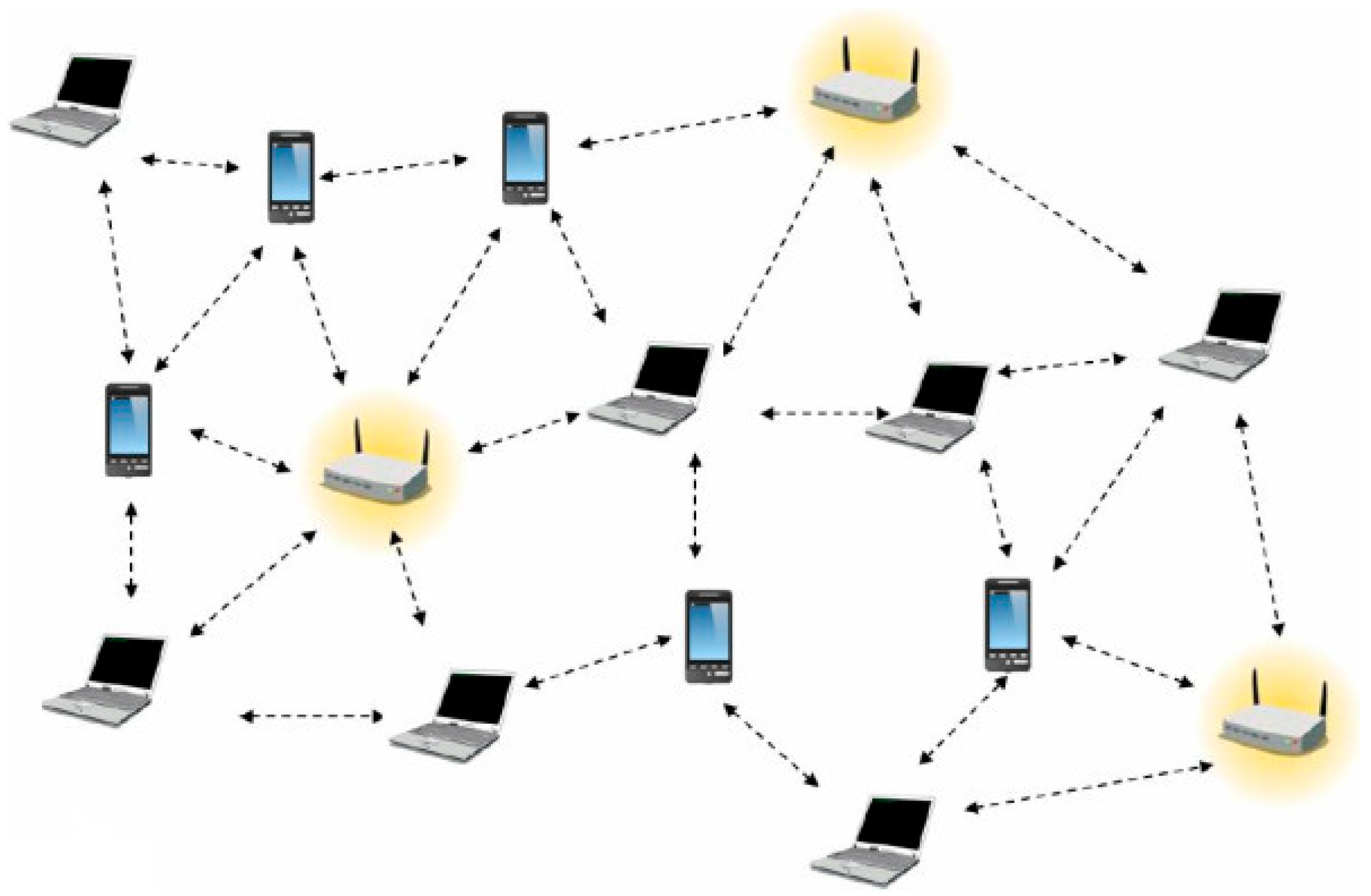
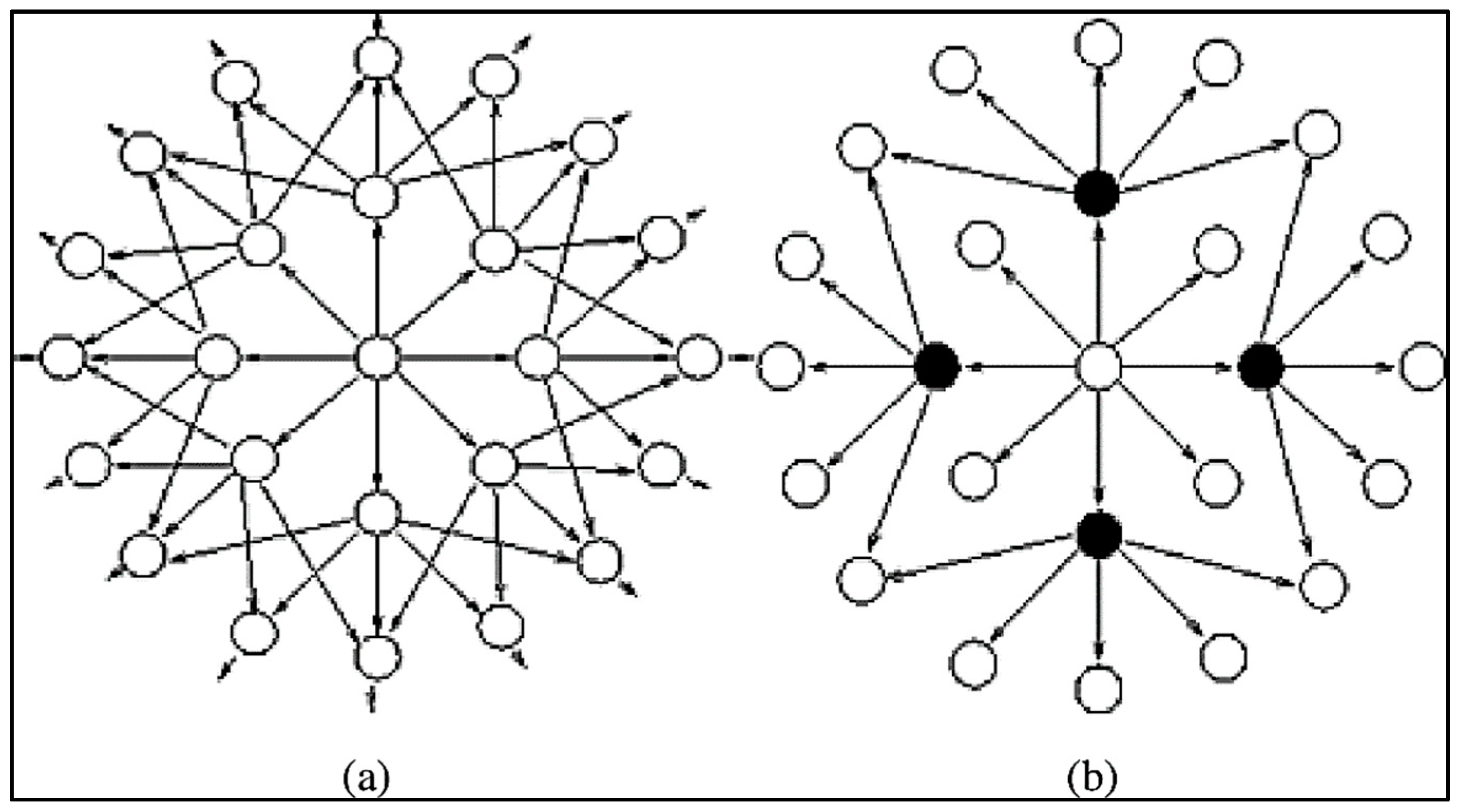
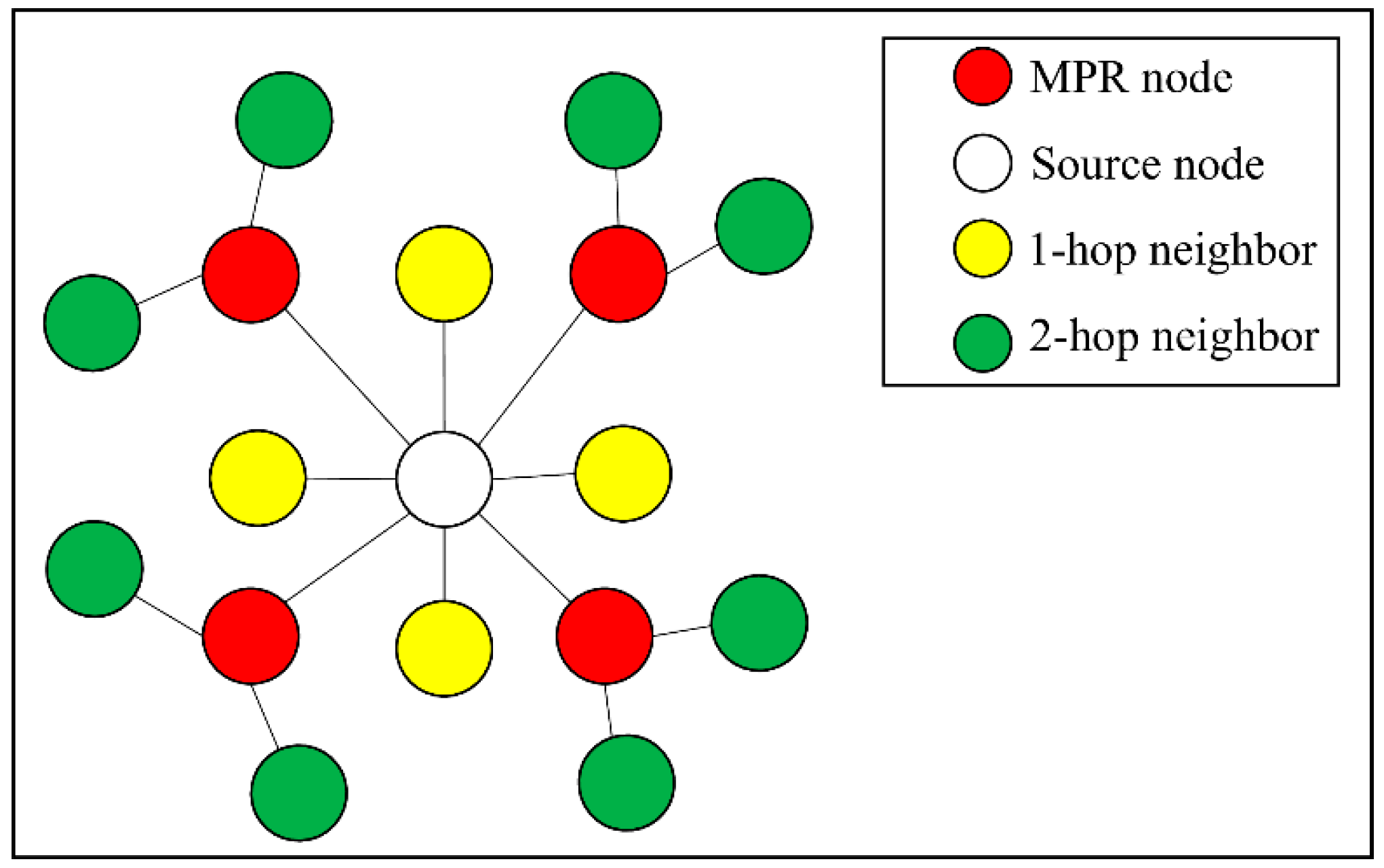

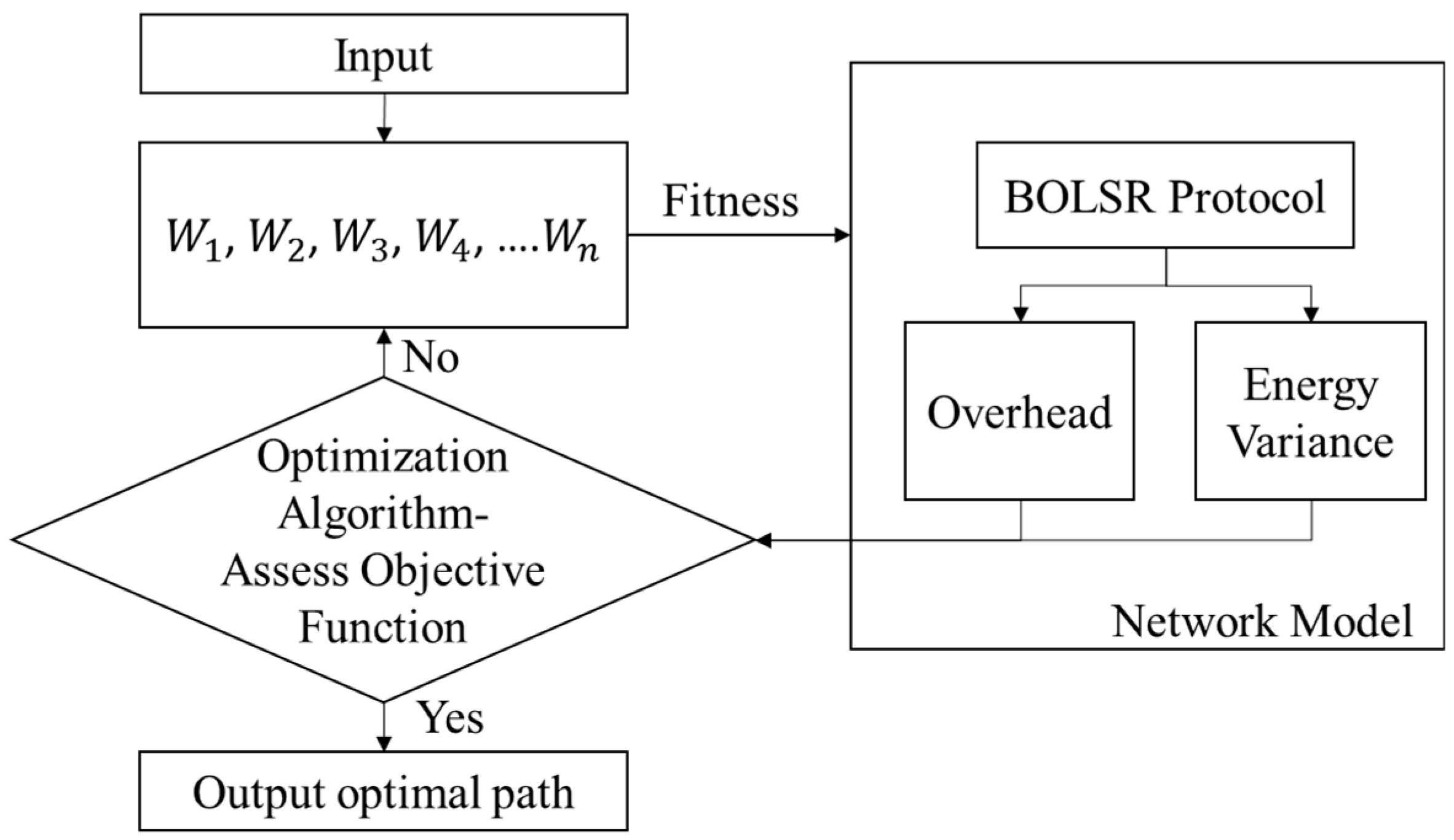

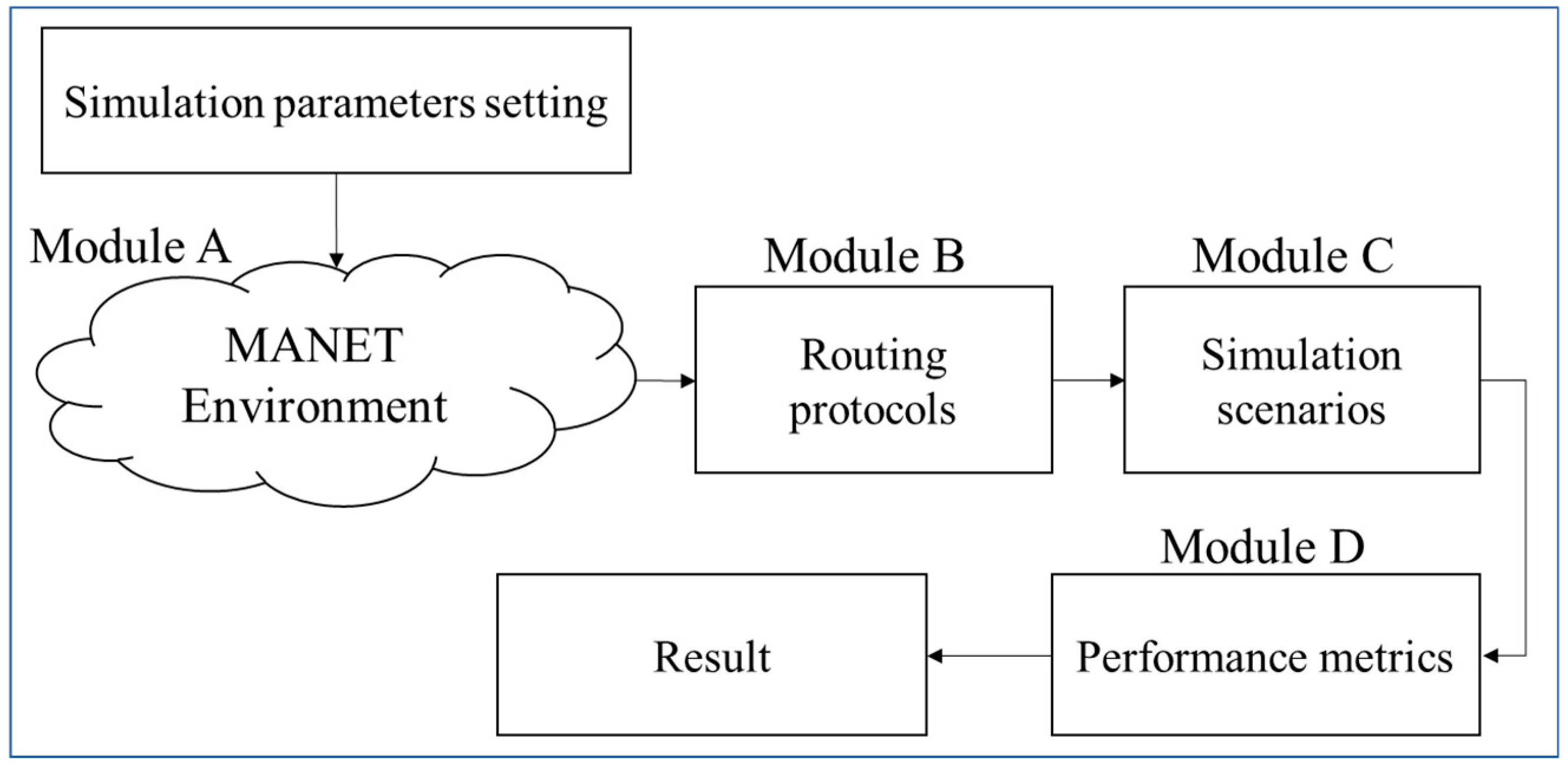
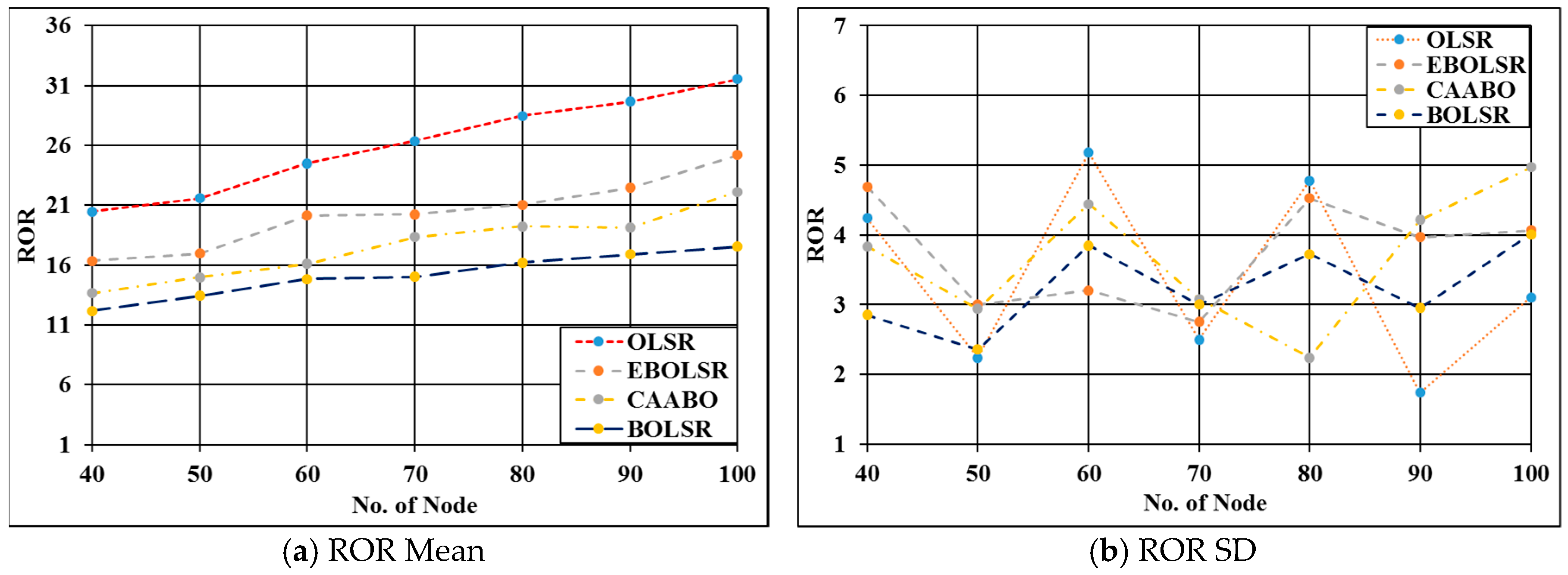
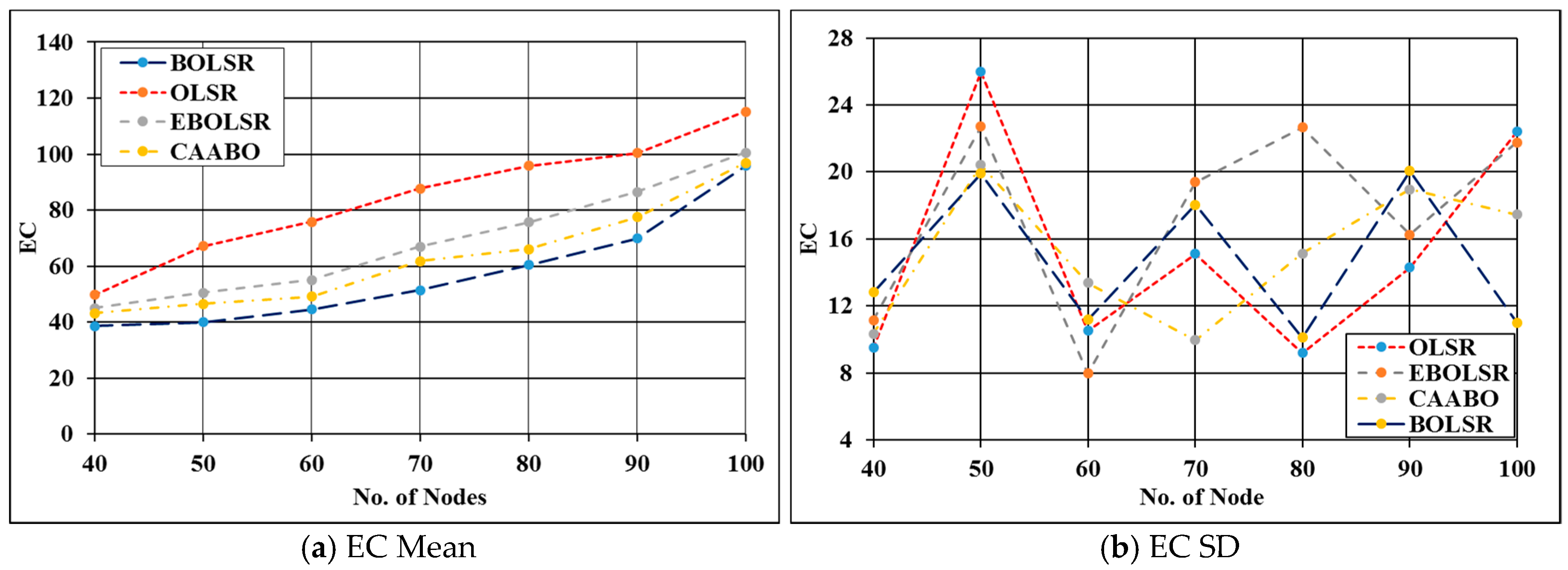
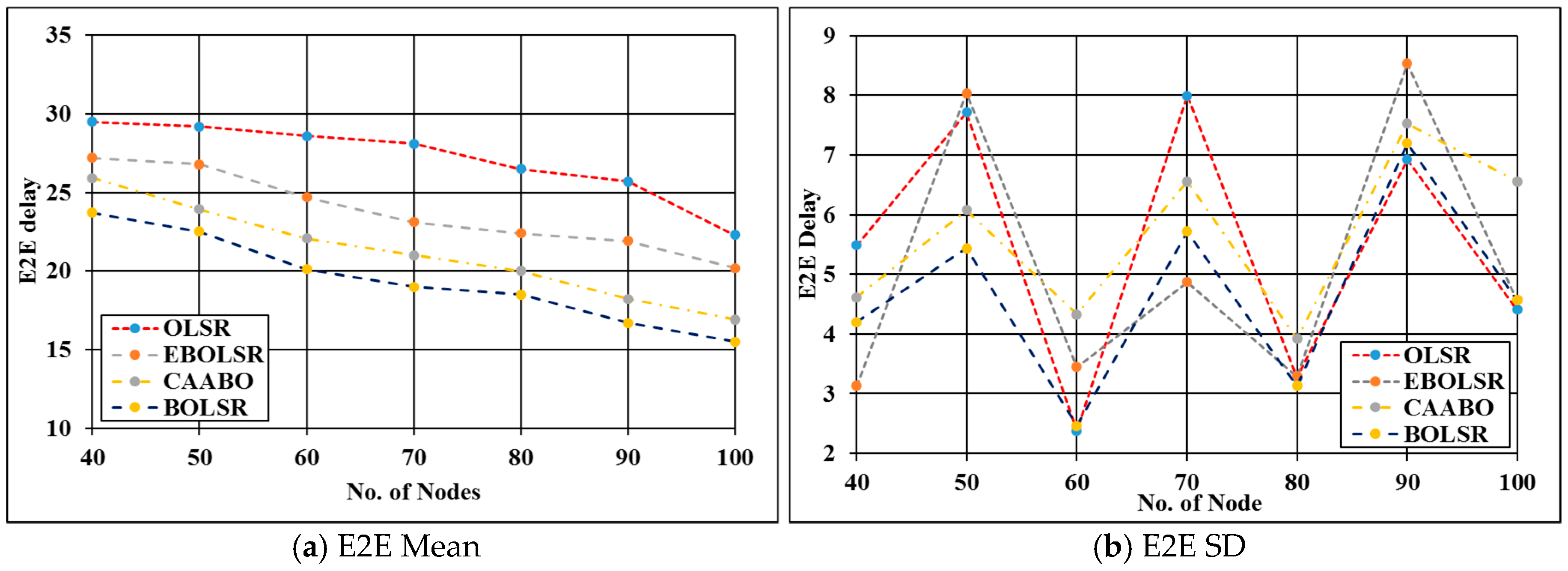


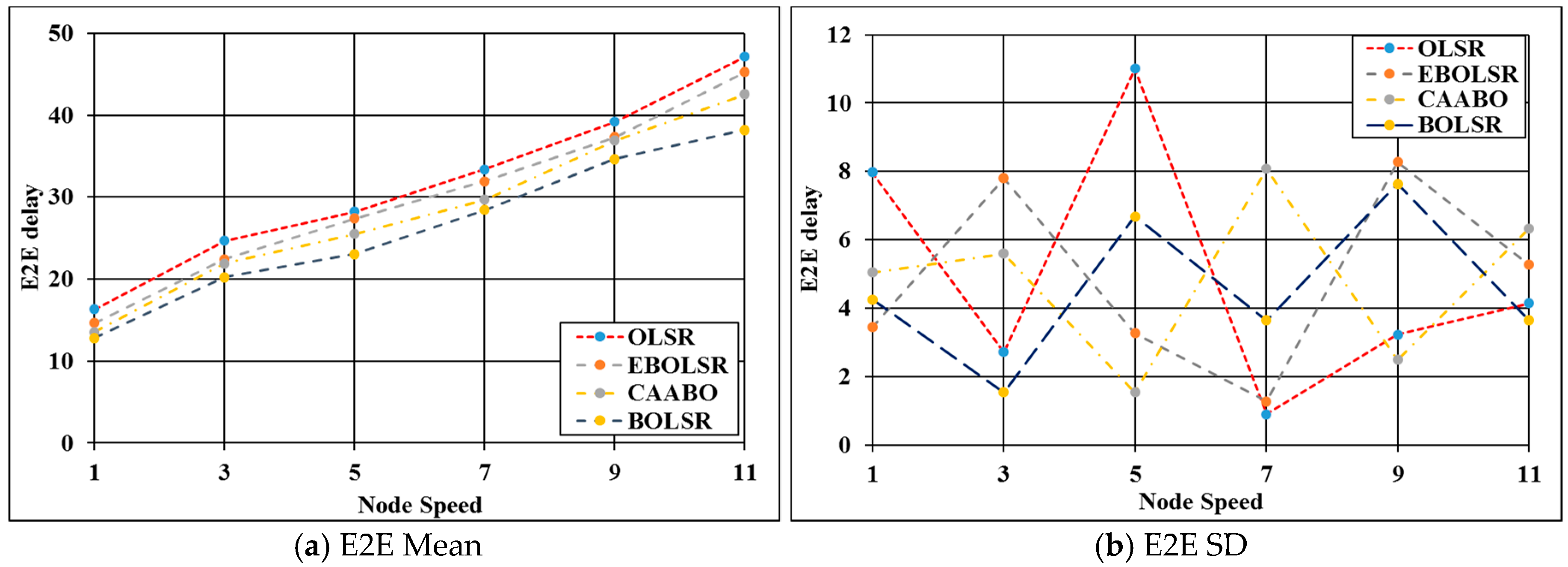

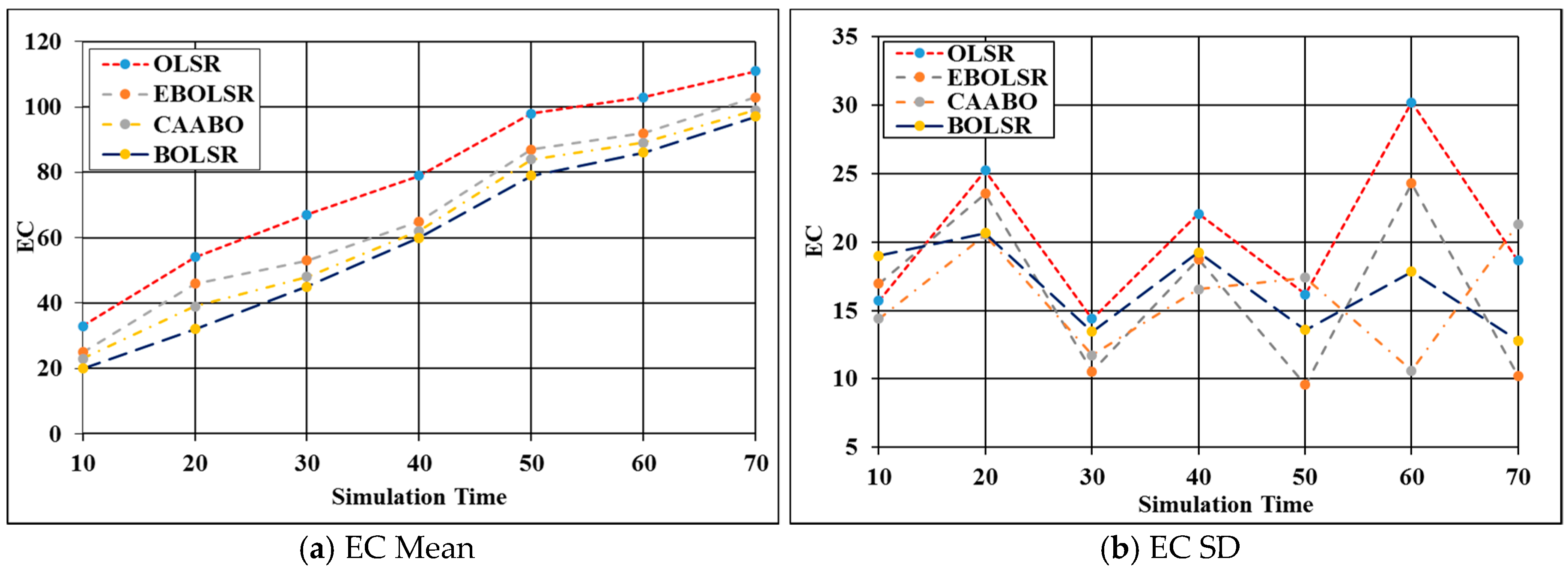

| Parameter | Value | Description |
|---|---|---|
| n | 20 | Number of solutions for each generation |
| d | 6 | The dimension of the bat algorithm |
| hB | 10 | Upper boundary |
| LB | −10 | Lower boundary |
| fmin | 0 | Lower frequency |
| fmax | 10 | Higher frequency |
| Alpha | 0.9 | Constants |
| Gama | 0.04 | Constants |
| Parameter | Value | Unit |
|---|---|---|
| No. of run | 5 | - |
| Queue size | 50 | Packet |
| Mobility Model | Random Way Point | - |
| Packet Size | 512 | Byte |
| Transmission Range | 250 | Meter |
| Protocol | OLSR, BOLSR, EBOLSR, CAABO | - |
| Area | 1250 | 2 |
| Nodes | (40–100) | nodes |
| Simulation time | (10–70) | |
| Node speed | (1–11) | |
| Traffic type | CBR/UDP | - |
| Packet size | 512 | |
| Transmit power | 1.4 | |
| Reception power | 1.0 | |
| Idle power | 0.05 |
| Model | Number of Nodes | ||||||||
|---|---|---|---|---|---|---|---|---|---|
| Criterion | Protocol | 40 | 50 | 60 | 70 | 80 | 90 | 100 | |
| PDR | OLSR | Mean | 55.3 | 57 | 60 | 62.8 | 65.1 | 69.3 | 71.2 |
| SD | 4.24 | 2.24 | 5.18 | 2.50 | 4.78 | 1.74 | 3.11 | ||
| EBOLSR | Mean | 63.2 | 66.4 | 69.5 | 70.1 | 72.7 | 74.4 | 80.3 | |
| SD | 4.69 | 3.00 | 3.21 | 2.76 | 4.53 | 3.97 | 4.07 | ||
| CAABO | Mean | 68.51 | 71.03 | 74.61 | 74.88 | 79.29 | 84.05 | 84.90 | |
| SD | 3.84 | 2.94 | 4.44 | 3.08 | 2.24 | 4.22 | 4.97 | ||
| BOLSR | Mean | 73.33 | 74.6 | 77.5 | 79.1 | 84.6 | 87.9 | 90.4 | |
| SD | 2.85 | 2.36 | 3.85 | 3.00 | 3.73 | 2.95 | 4.01 | ||
| E2E | OLSR | Mean | 29.5 | 29.2 | 28.6 | 28.1 | 26.5 | 25.7 | 22.3 |
| SD | 5.49 | 7.71 | 2.38 | 8.00 | 3.27 | 6.92 | 4.41 | ||
| EBOLSR | Mean | 27.2 | 26.8 | 24.7 | 23.1 | 22.4 | 21.9 | 20.2 | |
| SD | 3.13 | 8.04 | 3.45 | 4.87 | 3.29 | 8.53 | 4.57 | ||
| CAABO | Mean | 25.92 | 23.93 | 22.07 | 21 | 19.99 | 18.24 | 16.93 | |
| SD | 4.62 | 6.08 | 4.33 | 6.55 | 3.92 | 7.53 | 6.55 | ||
| BOLSR | Mean | 23.7 | 22.5 | 20.1 | 19 | 18.5 | 16.7 | 15.5 | |
| SD | 4.20 | 5.43 | 2.46 | 5.71 | 3.13 | 7.19 | 4.57 | ||
| ROR | OLSR | Mean | 20.45 | 21.59 | 24.5 | 26.36 | 28.47 | 29.65 | 31.52 |
| SD | 7.99 | 5.63 | 9.35 | 6.46 | 5.10 | 6.73 | 3.63 | ||
| EBOLSR | Mean | 16.35 | 16.96 | 20.14 | 20.23 | 21.02 | 22.44 | 25.18 | |
| SD | 5.64 | 7.77 | 4.91 | 7.98 | 3.71 | 7.49 | 5.53 | ||
| CAABO | Mean | 13.65 | 14.96 | 16.09 | 18.33 | 19.23 | 19.11 | 22.11 | |
| SD | 6.73 | 4.71 | 8.08 | 5.60 | 7.62 | 3.90 | 6.72 | ||
| BOLSR | Mean | 12.16 | 13.43 | 14.82 | 15.01 | 16.19 | 16.88 | 17.54 | |
| SD | 4.20 | 6.24 | 3.92 | 6.88 | 3.68 | 6.28 | 4.73 | ||
| EC | OLSR | Mean | 49.76 | 67.23 | 75.84 | 87.74 | 95.81 | 100.34 | 115.21 |
| SD | 9.50 | 25.98 | 10.51 | 15.12 | 9.20 | 14.29 | 22.41 | ||
| EBOLSR | Mean | 45.07 | 50.49 | 55.15 | 67.06 | 75.7 | 86.53 | 100.52 | |
| SD | 11.15 | 22.71 | 7.96 | 19.39 | 22.67 | 16.26 | 21.77 | ||
| CAABO | Mean | 43.15 | 46.52 | 49.09 | 61.81 | 66.01 | 77.48 | 96.94 | |
| SD | 10.34 | 20.41 | 13.38 | 9.96 | 15.14 | 18.97 | 17.46 | ||
| BOLSR | Mean | 38.56 | 39.99 | 44.59 | 51.38 | 60.43 | 69.93 | 95.84 | |
| SD | 12.81 | 19.89 | 11.19 | 18.04 | 10.11 | 20.07 | 11.01 | ||
| Model | Node Speed | |||||||
|---|---|---|---|---|---|---|---|---|
| Criterion | Protocol | 1 | 3 | 5 | 7 | 9 | 11 | |
| PDR | OLSR | Mean | 96.79 | 90.46 | 82.7 | 72.41 | 67.35 | 65.4 |
| SD | 6.28 | 15.48 | 3.03 | 11.90 | 5.04 | 10.00 | ||
| EBOLSR | Mean | 97.7 | 93.02 | 83.44 | 79.25 | 74.7 | 71.1 | |
| SD | 4.21 | 9.04 | 6.77 | 13.37 | 11.55 | 12.05 | ||
| CAABO | Mean | 98.16 | 95.31 | 84.89 | 79.98 | 75.23 | 73.35 | |
| SD | 5.33 | 7.07 | 1.76 | 11.10 | 1.54 | 9.75 | ||
| BOLSR | Mean | 98.55 | 96.3 | 86.1 | 81.5 | 77.8 | 75.3 | |
| SD | 7.49 | 11.34 | 8.34 | 11.53 | 6.91 | 12.22 | ||
| E2E | OLSR | Mean | 16.32 | 24.67 | 28.21 | 33.41 | 39.21 | 47.11 |
| SD | 7.97 | 2.71 | 11.01 | 0.90 | 3.23 | 4.14 | ||
| EBOLSR | Mean | 14.63 | 22.41 | 27.41 | 31.92 | 37.31 | 45.25 | |
| SD | 3.45 | 7.81 | 3.27 | 1.27 | 8.27 | 5.27 | ||
| CAABO | Mean | 13.54 | 21.92 | 25.5 | 29.67 | 36.88 | 42.53 | |
| SD | 5.05 | 5.60 | 1.54 | 8.07 | 2.49 | 6.33 | ||
| BOLSR | Mean | 12.81 | 20.21 | 23.04 | 28.42 | 34.67 | 38.21 | |
| SD | 4.25 | 1.54 | 6.69 | 3.64 | 7.64 | 3.64 | ||
| ROR | OLSR | Mean | 21.79 | 38.46 | 58.18 | 67.29 | 69.92 | 72.32 |
| SD | 9.57 | 3.02 | 6.34 | 2.13 | 11.88 | 5.67 | ||
| EBOLSR | Mean | 19.2 | 32.2 | 44.61 | 54.76 | 63.64 | 67.49 | |
| SD | 1.76 | 9.67 | 3.90 | 10.15 | 7.58 | 8.61 | ||
| CAABO | Mean | 18.45 | 30.73 | 41.41 | 51.32 | 59.92 | 64.02 | |
| SD | 4.90 | 8.83 | 3.39 | 11.63 | 5.42 | 12.76 | ||
| BOLSR | Mean | 18.12 | 29.85 | 39.44 | 48.6 | 55.6 | 59.4 | |
| SD | 2.32 | 5.79 | 2.83 | 6.82 | 4.01 | 7.63 | ||
| EC | OLSR | Mean | 72 | 83 | 94 | 123 | 157 | 168 |
| SD | 9.82 | 6.84 | 5.34 | 9.41 | 4.64 | 4.06 | ||
| EBOLSR | Mean | 65 | 74 | 89 | 111 | 135 | 145 | |
| SD | 8.28 | 3.55 | 8.60 | 6.51 | 9.55 | 4.30 | ||
| CAABO | Mean | 62 | 71 | 85 | 104 | 129 | 137 | |
| SD | 6.60 | 5.10 | 8.06 | 2.93 | 8.66 | 4.53 | ||
| BOLSR | Mean | 61 | 69 | 82 | 98 | 119 | 129 | |
| SD | 5.95 | 4.33 | 7.02 | 4.52 | 7.18 | 6.67 | ||
| Model | Simulation Time | ||||||||
|---|---|---|---|---|---|---|---|---|---|
| Criterion | Protocol | 10 | 20 | 30 | 40 | 50 | 60 | 70 | |
| PDR | OLSR | Mean | 70.23 | 72.89 | 74.05 | 77.37 | 80.22 | 82.53 | 85.39 |
| SD | 3.61 | 6.85 | 2.84 | 5.02 | 4.06 | 6.02 | 3.44 | ||
| EBOLSR | Mean | 73.8 | 75.1 | 77.31 | 80.19 | 83.3 | 84.13 | 88.31 | |
| SD | 4.85 | 6.55 | 3.83 | 5.28 | 2.49 | 5.79 | 6.56 | ||
| CAABO | Mean | 76.61 | 78.91 | 79.73 | 83.51 | 87.87 | 89.99 | 91.01 | |
| SD | 2.55 | 6.93 | 5.26 | 7.05 | 5.97 | 6.69 | 5.59 | ||
| BOLSR | Mean | 78.36 | 80.63 | 83.71 | 86.3 | 90.91 | 93.2 | 95.25 | |
| SD | 3.05 | 5.56 | 3.77 | 5.95 | 4.39 | 6.13 | 4.86 | ||
| E2E | OLSR | Mean | 11.61 | 17.55 | 20.22 | 26.56 | 30.68 | 32.12 | 33.11 |
| SD | 3.24 | 5.44 | 3.39 | 4.67 | 3.67 | 3.85 | 3.49 | ||
| EBOLSR | Mean | 10.12 | 16.54 | 18.85 | 22.68 | 27.11 | 29.71 | 30.25 | |
| SD | 4.06 | 5.70 | 3.74 | 5.55 | 4.21 | 5.83 | 5.52 | ||
| CAABO | Mean | 9.67 | 13.1 | 16.34 | 20.21 | 25.07 | 27.87 | 28.23 | |
| SD | 3.50 | 4.87 | 3.13 | 3.39 | 4.51 | 3.74 | 3.27 | ||
| BOLSR | Mean | 8.07 | 11.78 | 14.37 | 18.41 | 21.61 | 24.21 | 26.31 | |
| SD | 3.67 | 4.35 | 3.32 | 4.88 | 3.30 | 4.59 | 3.76 | ||
| ROR | OLSR | Mean | 39.74 | 41.78 | 43.62 | 47.16 | 48.27 | 49.92 | 50.12 |
| SD | 0.84 | 4.16 | 2.07 | 1.34 | 3.08 | 1.30 | 3.21 | ||
| EBOLSR | Mean | 34.19 | 36.29 | 39.83 | 43.02 | 44.54 | 46.28 | 47.34 | |
| SD | 2.88 | 2.55 | 3.29 | 2.95 | 1.73 | 3.11 | 4.02 | ||
| CAABO | Mean | 33.11 | 35.04 | 39.44 | 42.34 | 42.67 | 44.85 | 46.91 | |
| SD | 1.13 | 3.21 | 2.21 | 3.58 | 1.81 | 3.85 | 2.83 | ||
| BOLSR | Mean | 31.97 | 33.07 | 38.29 | 40.66 | 41.53 | 43.33 | 45.26 | |
| SD | 1.64 | 2.95 | 1.43 | 3.44 | 1.98 | 4.16 | 2.23 | ||
| EC | OLSR | Mean | 33 | 54 | 67 | 79 | 98 | 103 | 111 |
| SD | 15.69 | 25.21 | 14.40 | 22.07 | 16.17 | 30.19 | 18.64 | ||
| EBOLSR | Mean | 25 | 46 | 53 | 65 | 87 | 92 | 103 | |
| SD | 16.95 | 23.53 | 10.55 | 18.74 | 9.56 | 24.27 | 10.22 | ||
| CAABO | Mean | 23 | 39 | 48 | 62 | 84 | 89 | 99 | |
| SD | 14.40 | 20.53 | 11.72 | 16.55 | 17.38 | 10.59 | 21.31 | ||
| BOLSR | Mean | 20 | 32 | 45 | 60 | 79 | 86 | 97 | |
| SD | 18.99 | 20.65 | 13.46 | 19.23 | 13.57 | 17.82 | 12.78 | ||
© 2019 by the authors. Licensee MDPI, Basel, Switzerland. This article is an open access article distributed under the terms and conditions of the Creative Commons Attribution (CC BY) license (http://creativecommons.org/licenses/by/4.0/).
Share and Cite
Jubair, M.A.; Mostafa, S.A.; Muniyandi, R.C.; Mahdin, H.; Mustapha, A.; Hassan, M.H.; Mahmoud, M.A.; Al-Jawhar, Y.A.; Al-Khaleefa, A.S.; Mahmood, A.J. Bat Optimized Link State Routing Protocol for Energy-Aware Mobile Ad-Hoc Networks. Symmetry 2019, 11, 1409. https://doi.org/10.3390/sym11111409
Jubair MA, Mostafa SA, Muniyandi RC, Mahdin H, Mustapha A, Hassan MH, Mahmoud MA, Al-Jawhar YA, Al-Khaleefa AS, Mahmood AJ. Bat Optimized Link State Routing Protocol for Energy-Aware Mobile Ad-Hoc Networks. Symmetry. 2019; 11(11):1409. https://doi.org/10.3390/sym11111409
Chicago/Turabian StyleJubair, Mohammed Ahmed, Salama A. Mostafa, Ravie Chandren Muniyandi, Hairulnizam Mahdin, Aida Mustapha, Mustafa Hamid Hassan, Moamin A. Mahmoud, Yasir Amer Al-Jawhar, Ahmed Salih Al-Khaleefa, and Ahmed Jubair Mahmood. 2019. "Bat Optimized Link State Routing Protocol for Energy-Aware Mobile Ad-Hoc Networks" Symmetry 11, no. 11: 1409. https://doi.org/10.3390/sym11111409








